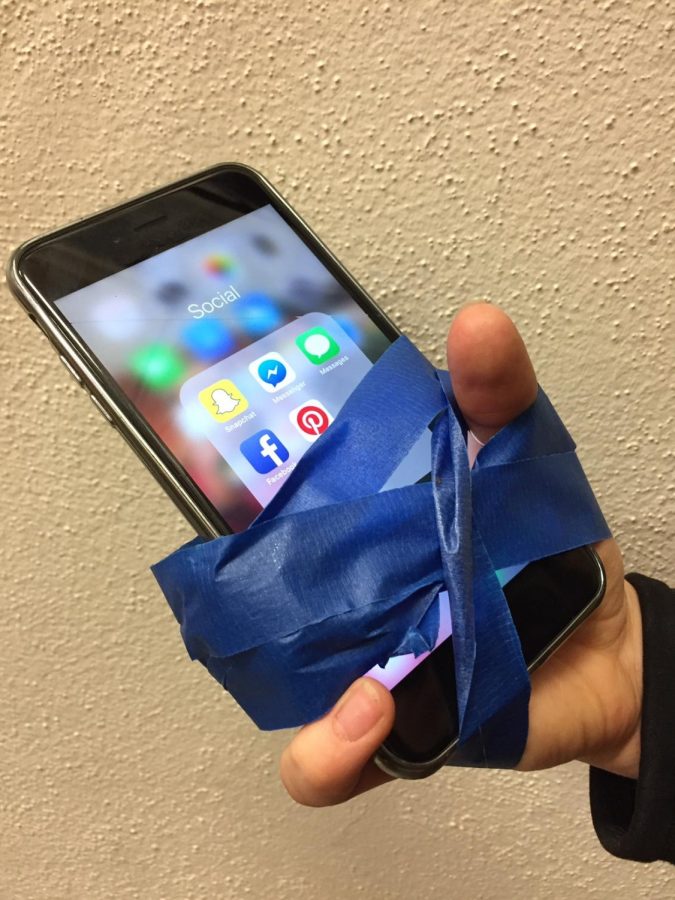Is Social Media Making Us Unsocial?
December 13, 2018
There’s a serious virus at Helena High School. This virus isn’t just at Helena High School. In fact, 94% of high schoolers have it. The virus takes over and rewires our brains, causing us to waste around four hours a day on average doing nothing. The name of this virus? Social media.
Although it seems tamer than it’s made out to be, social media has very negative effects on teens. A PEW research study found that roughly 42% percent of teens felt anxious or nervous when separated from their phones. The bad news doesn’t stop there. The study also found that teens are spending 4 hours each day on screens, with a majority of that time dedicated to social media. This addiction is entirely visible at Helena High. Many students struggle going the duration of a class period without sneaking a look at their phones. For those who manage to make it through the 50 minutes typically take out their phones the moment the bell rings and then are glued to them. Many students claim that the time spent on their phones between classes is minimal, but these five-minute fixes add up. Along with this, students are spending the 36 minutes offered for lunch attached to social media, catching up on memes or the latest freshman fight. (Side Note: Guys. Really? Find a better way to settle your differences. Its 10/10 not cool). While moth memes are good, students are spending vital time in a virtual world, rather than talking with friends and forming meaningful relationships.
This issue made an impact after the 2017-2018 school year, enough for the school to tighten its phone policy, as well as encouraging teachers to take a tougher stance on the issue. As students entered the 2018-2019 school year, most teachers made it clear that they were serious about a low tolerance policy when dealing with phones. Along with this, the school policy on phones became stricter, now requiring a parent to pick up the confiscated phone at the second violation versus the third. Although these policies targeted phones and not social media, they may have been driven by students’ constant gravitation towards social media and therefore their phones.
It’s not just teachers and administrators who are recognizing the gravity of this issue. Many students are getting rid of social media not only to limit screen time, but to remove a source of stress and toxicity. Jackson Wetherill, a junior at Helena High, recently got rid of Instagram. “I didn’t like the way I sounded on my post, and I was spending way too much time on it,” Wetherill said. He continued, “I think it’s so hard to be detached from social media in high school, but it has to be healthier.” School counselors and psychologists alike have pointed out the danger to mental health that social media poses. Jason Murgel, a counselor at Helena High, said that social media is linked to increased rates of depression and anxiety. Along with this, it has major negative impacts on attention span. Despite this, to some teens it acts as a stimulant and fuel for the ego, as it can be used as a tool to advertise an “I’m cooler than you” message. On the flip side, this message can put others down, as they feel like they must live up to a standard set by their peers and celebrities. This inability to meet a mythical standard can have serious impacts on body image and self-worth.
And it goes deeper. Reduced self-image is bad, but our usage of social media has rewired our brains and our chemical signals. When we get notifications, they make us happy. We’re happy to talk to someone, to see something funny, and this releases endorphins in the body. As or usage increases, the body learns that social media is a quick, easy way to get a fix of endorphins, and so we spend time on it posting and getting likes that send off little fireworks of happiness. This seems good, but too much of a good thing can be bad. As the brain grows accustomed to the near constant feel of endorphins surging, when they aren’t present, we begin to feel anxious. This is why whenever we hear our phones vibrate, we get happy and feel a near aching sensation to look at it. Similarly, the body will fake vibrations in a phenomenon called “phantom vibration syndrome.” This is caused when the brain misinterprets signals from the body and believes they are notifications on a device. As discussed earlier, this releases endorphins and therefore the body will feign notifications to get the endorphins.
This is somewhat terrifying, so what can we do to stop it? For starters, you can turn off frequent notifications, but in the long run this won’t limit screen time. The best method is to get rid of social media or set daily time limits. Take your newfound time and read a book (Gasp! People still do that!?) or pick up a new hobby like playing the cello. It’s time for us as teenagers to take a stand against this virus. We must develop an antidote, or it might just be too late for us.


